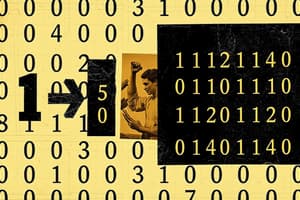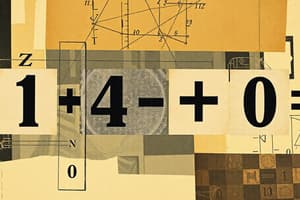Podcast
Questions and Answers
What is the correct approach to add 3.75 and 2.1?
What is the correct approach to add 3.75 and 2.1?
- Estimate the sum by rounding each number.
- Convert both numbers to fractions before adding. (correct)
- Align the decimal points and add as whole numbers. (correct)
- Add the numbers in any order without concern for decimal placement.
Which of the following shapes has the greatest area if all are in the same unit measurement?
Which of the following shapes has the greatest area if all are in the same unit measurement?
- A triangle with base 4 and height 5.
- A circle with a radius of 3. (correct)
- A rectangle with dimensions 2 by 6.
- A quadrilateral with sides measuring 4, 4, 4, and 4 (square). (correct)
Which of these methods is effective in finding the mean of a data set?
Which of these methods is effective in finding the mean of a data set?
- Add all numbers in the set and divide by the total count. (correct)
- Identify the largest number and the smallest number, then divide their sum by two.
- Count the frequency of each number and determine the most common value.
- Find the median and use that value as the mean.
When converting 50 centimeters to inches, what is the correct outcome?
When converting 50 centimeters to inches, what is the correct outcome?
In solving a word problem, what is the next logical step after identifying the unknown?
In solving a word problem, what is the next logical step after identifying the unknown?
Which statement accurately describes the difference between whole numbers and integers?
Which statement accurately describes the difference between whole numbers and integers?
What is the result of rounding the number 76.4 to the nearest ten?
What is the result of rounding the number 76.4 to the nearest ten?
Which of the following fractions is equivalent to 3/4?
Which of the following fractions is equivalent to 3/4?
When multiplying two integers, if one integer is negative and the other is positive, what will be the sign of the product?
When multiplying two integers, if one integer is negative and the other is positive, what will be the sign of the product?
Which operation is directly related to repeated addition?
Which operation is directly related to repeated addition?
What is the first step to take when simplifying the fraction 8/12?
What is the first step to take when simplifying the fraction 8/12?
Which property of addition states that changing the grouping of numbers does not change their sum?
Which property of addition states that changing the grouping of numbers does not change their sum?
When dividing the whole number 15 by 3, what is the quotient?
When dividing the whole number 15 by 3, what is the quotient?
Flashcards
Decimal Conversion
Decimal Conversion
Changing a fraction to a decimal, or a decimal to a fraction.
Decimal Addition/Subtraction
Decimal Addition/Subtraction
Adding or subtracting decimals by aligning the decimal points.
Decimal Multiplication/Division
Decimal Multiplication/Division
Multiplying and dividing decimals by placing the decimal in the multiplication and division results, based of the decimals in the calculation factors.
Rounding Decimals
Rounding Decimals
Signup and view all the flashcards
Problem Solving Strategy
Problem Solving Strategy
Signup and view all the flashcards
Whole Numbers
Whole Numbers
Signup and view all the flashcards
Integers
Integers
Signup and view all the flashcards
Rational Numbers
Rational Numbers
Signup and view all the flashcards
Place Value
Place Value
Signup and view all the flashcards
Adding/Subtracting Integers
Adding/Subtracting Integers
Signup and view all the flashcards
Multiplying Integers
Multiplying Integers
Signup and view all the flashcards
Multiplying Whole Numbers
Multiplying Whole Numbers
Signup and view all the flashcards
Equivalent Fractions
Equivalent Fractions
Signup and view all the flashcards
Study Notes
Number Systems and Operations
- Whole numbers: Numbers starting from 0 and increasing without fractions or decimals (e.g., 0, 1, 2, 3...).
- Integers: Whole numbers and their opposites (e.g., -3, -2, -1, 0, 1, 2, 3...).
- Rational numbers: Numbers that can be expressed as a fraction (p/q), where p and q are integers and q is not zero. Includes whole numbers, integers, and fractions.
- Understanding place value: Recognizing the value of digits based on their position in a number (e.g., ones, tens, hundreds, thousands...).
- Ordering numbers: Placing numbers in ascending or descending order.
- Comparing numbers: Determining which number is greater or smaller.
- Rounding numbers: Approximating a number to a specific place value.
Addition and Subtraction
- Adding and subtracting whole numbers: Combining or separating quantities.
- Adding and subtracting integers: Understanding rules for signs (+ and -).
- Properties of addition: Commutative (order doesn't matter), Associative (grouping doesn't matter), Identity (adding zero doesn't change a number).
- Estimating sums and differences: Using rounding to approximate results.
- Word problems involving addition and subtraction: Applying operations to solve real-world scenarios.
Multiplication and Division
- Multiplying whole numbers: Repeated addition.
- Multiplying integers: Determining the sign of the product based on the signs of the factors.
- Properties of multiplication: Commutative, Associative, Distributive, Identity (multiplying by 1).
- Dividing whole numbers: Finding how many times one number goes into another.
- Dividing integers: Understanding rules for signs when dividing.
- Long division: A standard algorithm for dividing larger numbers.
- Word problems involving multiplication and division: Applying operations to solve scenarios.
Fractions
- Understanding fractions: Representing parts of a whole.
- Equivalent fractions: Fractions that represent the same value.
- Comparing and ordering fractions: Determining which fraction is larger or smaller.
- Simplifying fractions: Reducing fractions to their lowest terms.
- Adding and subtracting fractions with common denominators: Combining or separating fractional parts.
- Multiplying and dividing fractions: Understanding the rules for these operations.
- Mixed numbers: Combining whole numbers and fractions.
Decimals
- Understanding decimals: Representing parts of a whole using place values.
- Converting between fractions and decimals: Changing one form to the other.
- Adding and subtracting decimals: Aligning decimal points.
- Multiplying and dividing decimals: Understanding the placement of the decimal point in the product or quotient.
- Rounding decimals: Approximating a decimal to a specific place value.
Measurement
- Units of length (e.g., inches, feet, centimeters, meters).
- Units of weight (e.g., ounces, pounds, grams, kilograms).
- Units of capacity (e.g., cups, pints, quarts, liters).
- Converting between units of measurement: Changing from one unit to another.
Geometry
- Basic shapes: Identifying and classifying shapes (e.g., triangles, quadrilaterals, circles).
- Angles: Measuring and classifying angles (acute, obtuse, right, straight).
- Perimeter: The distance around a two-dimensional shape.
- Area: The space inside a two-dimensional shape.
- Volume: The space occupied by a three-dimensional object.
- Attributes of shapes: Identifying properties like sides, angles, and vertices.
Data Analysis
- Collecting data: Gathering information through observations or surveys.
- Organizing data: Using tables, charts, and graphs to represent data.
- Analyzing data: Interpreting data to find patterns and draw conclusions.
- Representing data: Creating graphs like bar graphs, line graphs, and pictographs.
- Measures of central tendency (mean, median, mode): Summarizing data.
Problem Solving
- Reading and understanding word problems: Extracting key information and determining the operations needed.
- Identifying the unknown: Deciding what information is being sought.
- Deciding on a strategy: Choosing a method to answer the question.
- Estimating the answer: Determining a reasonable solution.
- Checking the answer: Ensuring the solution makes sense in the context of the problem.
Studying That Suits You
Use AI to generate personalized quizzes and flashcards to suit your learning preferences.




